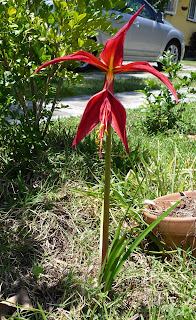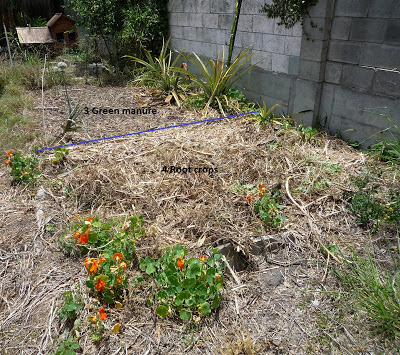After a few months without decent rainfall it has been raining since late yesterday afternoon. The water tank is filling up, the plants are getting a decent drink and the grass is looking greener already. Of course, while making me a very happy gardener, it's also not the best day to be out and about digging or to be a chicken. So instead it means bringing the gardening for the day. Inside! Hmm, sounds messy. Don't worry. I did the messy, dirt-flinging, pot tapping bit outside under the eaves, then went inside to finish off the green wall project.
So what's a green wall? I initially saw the idea on a programme about green home design. The overall concept (as for indoor plants) is to filter indoor air and also act as a temperature regulator. Although the show demonstrated a fixed wall with soil and plants in pockets or suspended pots, I thought I'd tweak it a little to make more of a green screen in the hope that this would mean a lighter structure requiring less maintenance (and expense to set up). To make the structure for it to climb on we screwed eyelets into the door-frame at 30cm intervals. Between these we strung fishing wire.
Then it came to choosing a plant. To make things impossible my criteria for the plant were:
a) dense enough to not look patchy and to fill the gaps properly between wires but
b) light enough not to stretch or collapse the wires
c) a native plant
d) one that's suitable for indoors
e) either non-flowering or non-allergenic and finally
f) preferably edible
With a little trawling through online nursery lists my mission was accomplished. There came up a plant that matched all the criteria perfectly: Lygodium microphyllum (also known as climbing maidenhair or Old World climbing fern). The nursery that had listed the plant was on the other side of town, a little too far to justify a specific trip in the car. So I waited and waited, hoping that I might need to go over that way for some other reason. Talking about this to my sister she offered to take me to a nursery a few streets from her place. Although most of the plants there were rather scorched and wilted specimens, the indoor plant section seemed to be well cared for. I spied a nice plant creeping along the ground and over a log. On closer inspection it turned out to be the exact plant I was after. The wait was over.
All that remained to do today was re-pot into a permanent container and wind it along the bottom rung. I had planned to get a new pot forgetting that I had a perfect sized one sitting outside that a friend had given me.
Voila! Green screen commenced. Grow little tendrils.
Note: Out of its natural habitat this plant has become a significant weed in Florida, US.
.jpg)
.jpg)
.jpg)
.jpg)
.jpg)
.jpg)
.jpg)
.jpg)
.jpg)
.jpg)
.jpg)
.jpg)
.jpg)
+(2).jpg)
.jpg)
.jpg)
.jpg)
.jpg)
.jpg)
.jpg)
.jpg)

.jpg)
.jpg)
.jpg)

.jpg)
.jpg)




.jpg)
.jpg)




.jpg)










